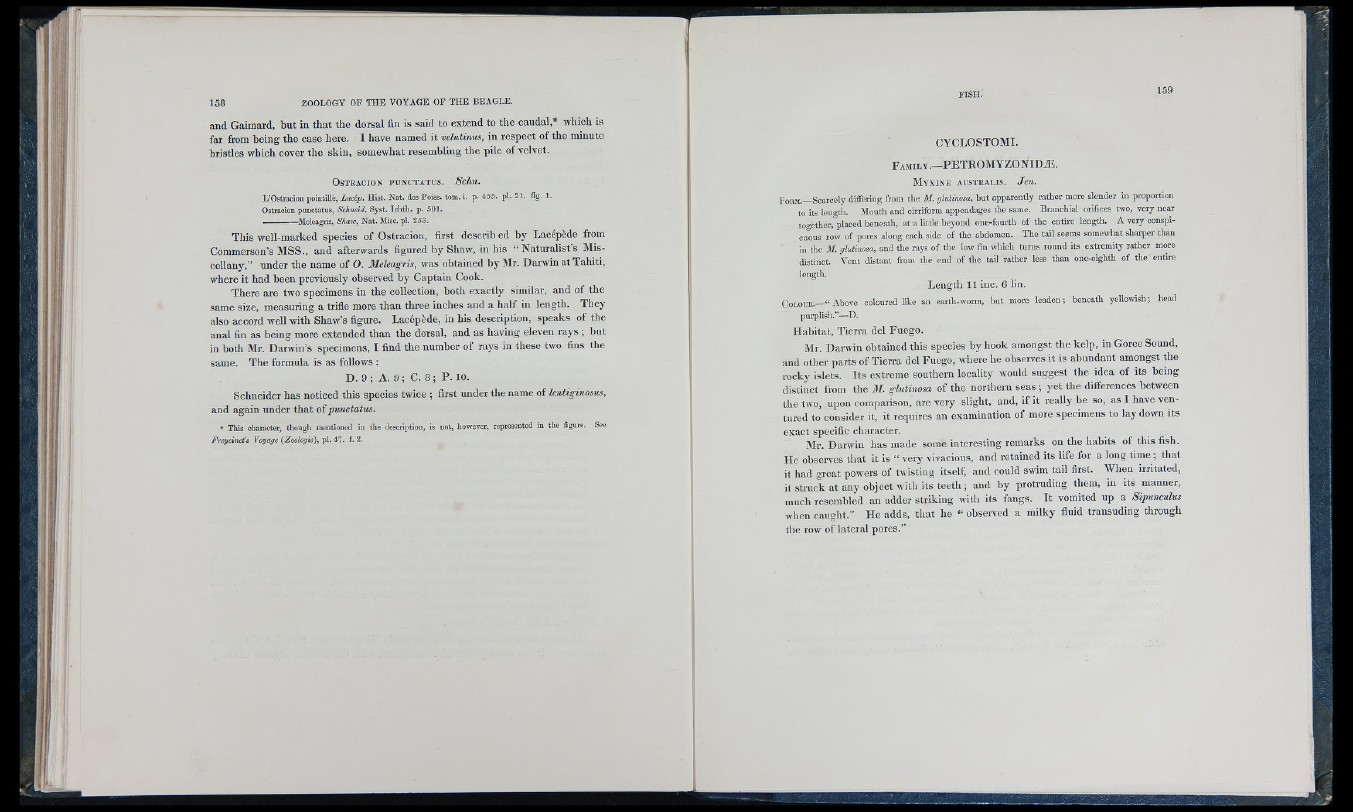
and Gaimard, but in that the dorsal fin is said to extend to the caudal,* which is
far from being the case here. I have named it velutinus, in respect of the minute
bristles which cover the skin, somewhat resembling the pile of velvet.
O s t r a c i o n p u n c t a t u s . Schn.
L’Ostracion pomtille, Lacep. Hist. Nat. des Poiss. toni. i. p- 455. pi. 21. fig. 1.
Ostracion punctatus, Schneid. Syst. Iclitli. p. 501.
■ ----—Meleagris, Shaw, Nat. Misc. pi. 253.
This well-marked species of Ostracion, first describ ed hy Lac^pMe from
Commerson’sM S S ., and afterwards figured by Shaw, in his “ N aturalist’s Miscellany,”
under the name of O. 3Ieleagris, was obtained by Mr. Darwin at Tahiti,
where it had been previously observed by Captain Cook.
There are two specimens in the collection, both exactly similar, and of the
same size, measuring a trifle more than three inches and a half in length. They
also accord well with Shaw’s figure. Lac^pfede, in his description, speaks of the
anal fin as being more extended than the dorsal, and as having eleven rays ; but
in both Mr. Darwin’s specimens, I find the number of rays in these two fins the
same. The formula is as follows :
D. 9 ; A. 9; C. 8 ; P. 10.
Schneider has noticed this species twice ; first under the name of lentiginosus,
and again under that oi punctatus.
* This character, though mentioned in the description, is not, however, represented in the figure. See
Freycinet's Voyage {Zoologie), pi. 47. f. 2.
CYCLOSTOMI.
F a m i l y .—PETROMYZONID®:.
M y x in e a u s t r a l i s . Jen,
F o r m .— Scarcely differing from tlie M . glutimsa, but apparently rather more slender in proportion
to its length. M outh and clrriform appendages the same. Branchial orifices two, very near
together, placed beneath, at a little beyond one-fourth o f the entire length. A very conspicuous
row of pores along each side of the abdomen. T he tail seems somewhat sharper than
in the M . ghtinom , and the rays o f the low fin which turns round its extrem ity rather more
distinct. V ent distant from the end of the tail rather less than one-eighth of the entire
length. Length 11 inc. 6 lin.
C o lo u r .- “ Above coloured like an earth-worm, but more leaden; beneath yeUowish; head
purplish.”— D.
H abitat, Tieri-a del Fuego.
Mr. Darwin obtained this species by hook amongst the kelp, in Goree Sound,
and other parts of Tierra del Fuego, where he observes it is abundant amongst the
rocky islets. Its extreme southern locality would suggest the idea of its being
distinct from the 31. ghUinosa of the northern seas; yet the differences between
the two, upon comparison, are very slight, and, if it really be so, as I have ventured
to consider it, it requires an examination of more specimens to lay down its
exact specific character.
Mr. Darwin has made some interesting remarks on the habits of this fish.
H e observes that it is “ very vivacious, and retained its life for a long tim e; that
it had great powers of twisting itself, and could swim tail first. When irritated,
it struck at any object with its teeth; and hy protruding them, in its manner,
much resembled an adder striking with its fangs. It vomited up a Sipunculm
when caught.” He adds, that he “ observed a milky fluid transuding through
the row of lateral pores.”